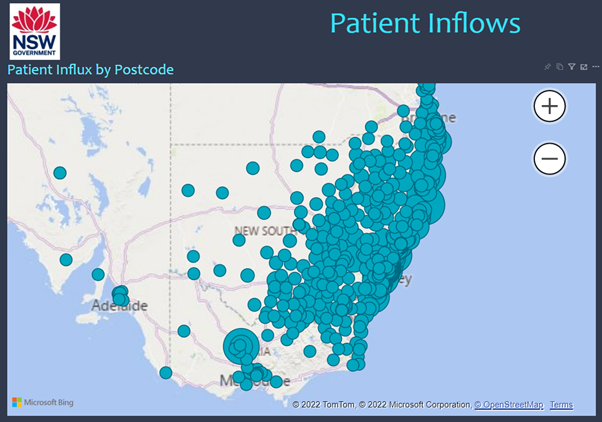NSW Cancer Registry: What we found - Usage
State-wide Reporting - via Reporting for Better Cancer Outcomes (RBCO)
New technologies in the data engineering and data collection space allow for rapid collection and quality assurance of clinical treatment data across the state. This provides more timely and accurate data made for the RBCO analysis team. Indicators that were unable to be produced previously are now being included and the confidence in the data being used has improved significantly.
“… the most significant changes have been probably improved data quality, which has meant we've been able to include a greater breadth of indicators - some new indicators or new data variables that may not have been available or may not have been robust [in the past] …”
Christen Stubbs, Manager Reporting and Systems Performance, Cancer Institute NSW
State-wide Service Planning - Ministry of Health
A state-wide aggregate radiotherapy operational data dashboard has been developed to support the Ministry of Health in radiation service planning across NSW. Prior to the delivery of the dashboard, the data had to be extracted and quality checked manually which impacted on data timeliness and currency. Now, data can be accessed straight away, thus providing accurate and timely information.

Press play to listen to Tina Ford's, Senior Planning and Policy Officer, Specialty Services and Technology Evaluation Unit, Ministry of Health, remarks.
Novel Reporting
During the COVID-19 pandemic, the Registry data were used for surveillance and monitoring – which is a novel use of such a large population-based registry collection. Data were extracted in advance of coding and used to monitor volumes and activity and impacts to that activity in health services across the state. Some tumour groups were identified as having risks to detection and treatment and so the Registry staff used AI algorithms to identify and fast track a subset of real time cases in order to enable more nuanced surveillance. This reporting was then regularly reviewed with the Ministry of Health and other pillars in order to identify possible actions/strategies needed within the health system.
“Cancer information from the Registry comes from carefully coded cases. It’s necessarily high quality and is considered the source of truth/fact in NSW. Recently the Registry demonstrated it can also provide valuable insights. In order to track cancer incidence in timely manner as COVID-19 brought pressure on the NSW health system, Registry staff advanced coded a random selection of 100 cases per month for key cancers. These smaller, but rapidly coded samples gave us timely insights into cancer incidence in the midst of the 2020 and 2021 COVID-19 disruptions.”
Richard Walton, Manager Biostatistics, CSI, Cancer Institute NSW
Research
The application of new technologies has also provided a research portal where de-identified cohorts can be identified for researchers to undertake further research projects aimed at better understanding patterns of care for specific cancer types.
For studies requiring prospective data collection, the Registry can be used to recruit patients. Approaching patients for research participation is best done by the Institute as this helps to generate a high consenting rate (about 68% during the past five [5] years). In 2011, 22 patient recruitment studies were conducted using the Registry. This number increased by 50% to 44 studies in 2019.
For studies requiring retrospective data, the Registry’s AI capabilities can check first whether the data exist to answer the research question. In this way, researchers can test and amend their research questions prior to ethics approval, thus making the research cycle more efficient. Retrospective radiotherapy data was provided to 10 researchers for linkage in 2021.
Watch the video to hear A/Prof David Smith's, Senior Research Fellow, Prostate Group Lead, Cancer Council NSW, comments.
“… since 2019 onwards [there] has been a phenomenal [change] in terms of the amount of data that is available for researchers, and the timeliness of the data … [and having access to] data of newly diagnosed people to follow up on the outcome of their diagnosis, on the timeliness of their diagnosis, or any issues affecting them.”
Sue Edwards, Data Access and Research Liaison Coordinator, Strategic Research and Investment Division, Cancer Institute, NSW
